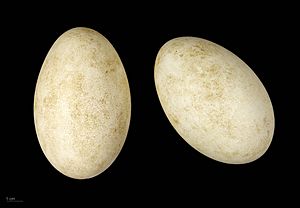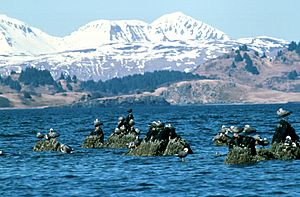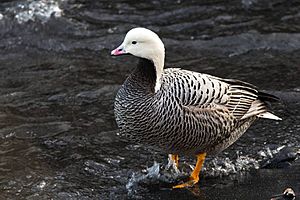Emperor goose facts for kids
Quick facts for kids Emperor goose |
|
|---|---|
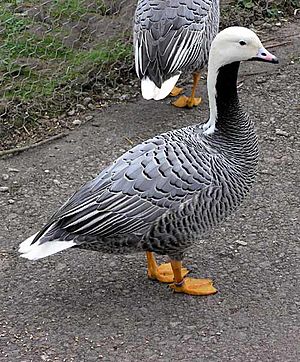 |
|
| An adult emperor goose | |
| Conservation status | |
| Scientific classification | |
| Genus: |
Anser
|
| Species: |
canagicus
|
| Synonyms | |
|
|
The emperor goose (Anser canagicus) is a type of water bird, like ducks and swans. People sometimes call it the beach goose or the painted goose.
Adult emperor geese are blue-gray and about 66 to 71 cm long. They have a black chin, pink beak, yellow-orange legs, and a white head. This white head often turns reddish-brown in summer. In winter, they live on muddy coasts in Alaska, and sometimes in Canada or the US. In summer, they fly north to colder arctic areas to have their babies. Older geese stay with the same partner for life.
They build nests in holes, adding plants and feathers. Eggs hatch in late June or early July. Baby geese, called goslings, leave the nest the same day they hatch. Emperor geese eat both plants and small animals. Their calls sound more "nasal" than other geese. The number of emperor geese is going down. This is because of things like pollution, hunting, and climate change. The International Union for Conservation of Nature says they are "near threatened".
Contents
What is an Emperor Goose?
The emperor goose was first described in 1802. It was named Anas canagica. Its name comes from Kanaga Island in the Aleutian Islands, Alaska. Sometimes, this goose has been placed in different groups, like the Chen genus. It has also been put in its own group called Philacte.
How to Spot an Emperor Goose
The emperor goose has a strong blue-gray body with black and white spots. These spots make it look like it has scales. Its head and the back of its neck are white, with a hint of amber-yellow. Unlike the snow goose, the white color does not go down the front of its neck.
This goose also has a black chin and throat. It has a white tail and a pink beak with a white tip. Its legs and feet are yellow-orange. The underside of its wings is gray. In summer, the heads of adult geese often turn reddish-brown. This happens because they eat in tidal pools that have iron oxide.
Young Emperor Geese
Baby geese, called goslings, are grayish-white when they hatch. Their beak is black, unlike the adults. For the first three weeks, goslings have gray, brown, or black feet. They also have a white area around their beak.
Young geese, called juveniles, are mostly gray. They have a small amount of white on their feathers. Younger juveniles have a dark head and neck. Their head looks dusty with some white spots. After October, their head and upper neck turn mostly white. But they still have some darker feathers. By their first winter, young geese look just like adult geese.
Size and Weight
Adult male emperor geese are about 66 to 71 cm long. Females are slightly smaller, about 65 to 70 cm long. Their wingspan is about 119 cm. They have short wings, so they fly slowly. They need to flap their wings quickly to stay in the air.
Males usually weigh between 2.7 and 3.1 kg. Females usually weigh about 1.9 kg. Young males weigh about 1.1 kg, and young females weigh about 1.1 kg. When they are about 5 to 7.5 weeks old, males weigh about 2.3 kg and females about 1.9 kg. This goose has a heavy body and a short neck compared to other geese.
Life Cycle and Behavior
Emperor geese are migratory birds. This means they travel north in the summer to have their babies. Then they fly south for the winter. Unlike many geese that fly thousands of miles, emperor geese only travel a few hundred miles. This is usually about 600 to 750 km.
Geese that are breeding will molt (lose their feathers) near their nesting areas. But geese that don't have babies will move to other islands to molt. The breeding season starts in late June in Russia. In Alaska, it begins a few weeks earlier, usually between May 20 and June 3. Only geese that are three years old or older will mate.
Reproduction and Family Life
Emperor geese are monogamous. This means the female goose stays with the same mate for her whole life. She will only find another male if her mate dies. The geese molt from late July to early August. They leave their breeding grounds later than other goose species.
Emperor geese build their nests on the tundra. They usually choose areas within 16 km of the coast. Nests are often built in marshes. They start as holes in the ground with no nesting material. But later, the female adds plants, like leaves, and feathers she pulls from herself.
The female usually lays 4 to 6 eggs. But she can lay anywhere from 2 to 8 eggs. Sometimes, eggs are laid in the nests of other emperor goose families. The eggs are about 7.8 cm by 5.2 cm. They are oval-shaped and smooth. They are white at first, but get stained from the nest. Only the female sits on the eggs to keep them warm. This usually takes 24 days. The male goose defends the nest, even though he doesn't help build it.
The eggs hatch in late June and early July. Baby geese can walk and swim just hours after hatching. They can also find their own food. They usually leave the nest the same day they hatch. But they stay close to their parents for about two months. Young geese can fly when they are 50 to 60 days old. About 10% of emperor geese live past their first year.
Emperor geese usually only spend time with their own family. However, larger groups gather during breeding and molting seasons. They are not very social geese. Only the black brant is less social. When they fly, they stay low, usually below 27 meters above the ground. They often fly so low that their wings almost touch the ground.
What They Eat
In summer, emperor geese eat plants. This includes shoots, roots, and berries. In winter, they mainly eat bivalve molluscs, like clams. They use their sense of touch to find these. They also eat algae. Unlike other geese, their diet has a lot of animals. This makes their meat taste strong. When they live near water, they eat at the water's edge. This is why they are called "Beach Geese".
If an emperor goose feels in danger, it will go into the water. It swims away until the danger is far away. Their calls sound like "kla-ha, kla-ha, kla-ha". They have a more "nasal" sound than other geese. They don't call as often as other geese, like the white-fronted goose. In zoos, they can live up to 25 years. But in the wild, they usually live to about 12 years old.
Where They Live
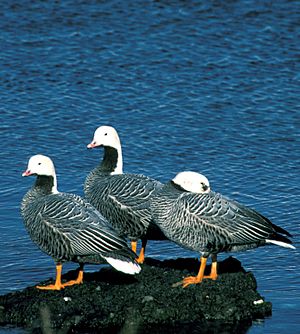
In summer, the emperor goose lives in cold arctic and subarctic areas. These are around the Bering Sea, Alaska, and a small part of northeast Russia. During this season, they live in freshwater pools, lakes, and coastal lagoons. Most of them (90%) build their nests on the Yukon–Kuskokwim Delta.
In winter, after flying south, they mostly live among the Aleutian Islands. They also live on the Alaska Peninsula and Kodiak Island. Sometimes, they spend winters in Canada. Rarely, they go as far south as northwestern California. In winter, they live on mudflats and rocky shores that are free of ice. In summer, they live in tundra wetlands. The area they live in is about 775,000 square kilometers.
As of 2017, the number of emperor geese is slowly increasing. In 1879, many emperor geese were found in the Yukon-Kuskokwim Delta. But by 1923, there were far fewer. People believed this was because many geese were killed and their eggs taken.
In 1964, there were 139,000 geese. This number dropped to 42,000 in 1986. After that, the population grew. There were 85,000 in 2002 and over 98,000 in 2015. The IUCN Red List says the total population is decreasing. However, it also notes that the trend is unclear and numbers are growing in some parts of North America. A wildlife expert said in 2017 that the population had more than doubled since the early 1980s. It might even be as large as 170,000.
Scientists don't fully know why the emperor goose population went down. But they think it's because of oil pollution, hunting, and climate change. Other reasons include competing with the cackling goose for food. Also, young goslings are sometimes eaten by predators.
The emperor goose is listed as "near threatened" on the IUCN Red List. It is also on the 2016 Watch List for North American birds. This list includes birds that are threatened but don't have major conservation plans. Because their numbers were low in the 1980s, hunting for these geese was stopped in 1986 and 1987.
However, 30 years later, hunting became legal again as the population grew. In 2017, people were allowed to hunt emperor geese for food. In fall 2017, people in Alaska could hunt them for fun with a permit. They could only take one bird per person. In 2018, hunters not living in Alaska could also get a permit. But you cannot hunt this species anywhere else in the United States.
See also
 In Spanish: Ánsar emperador para niños
In Spanish: Ánsar emperador para niños




